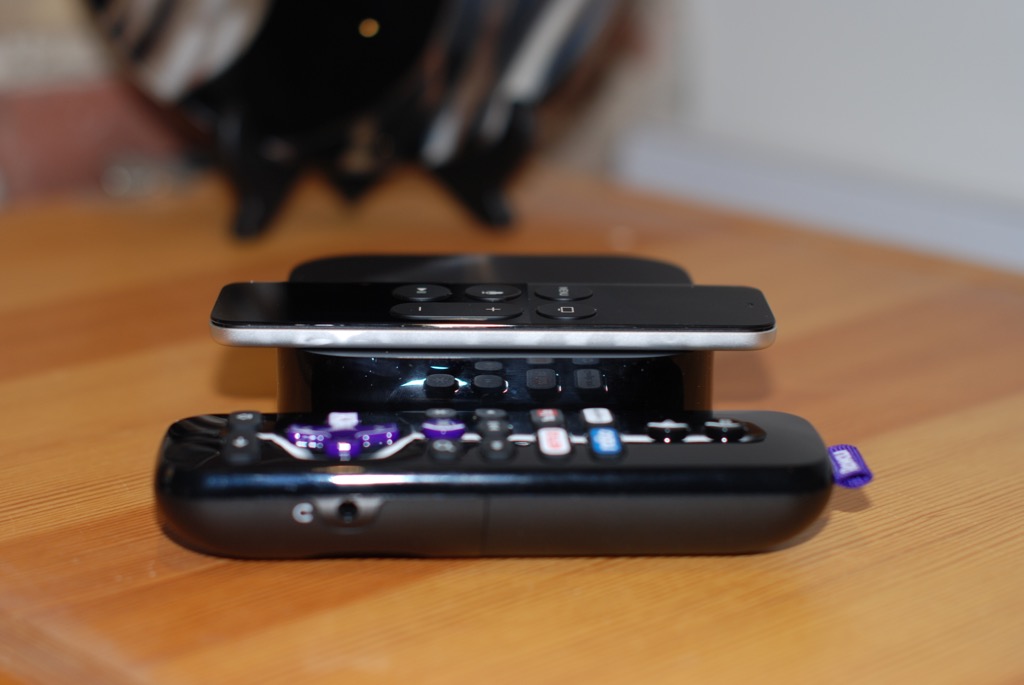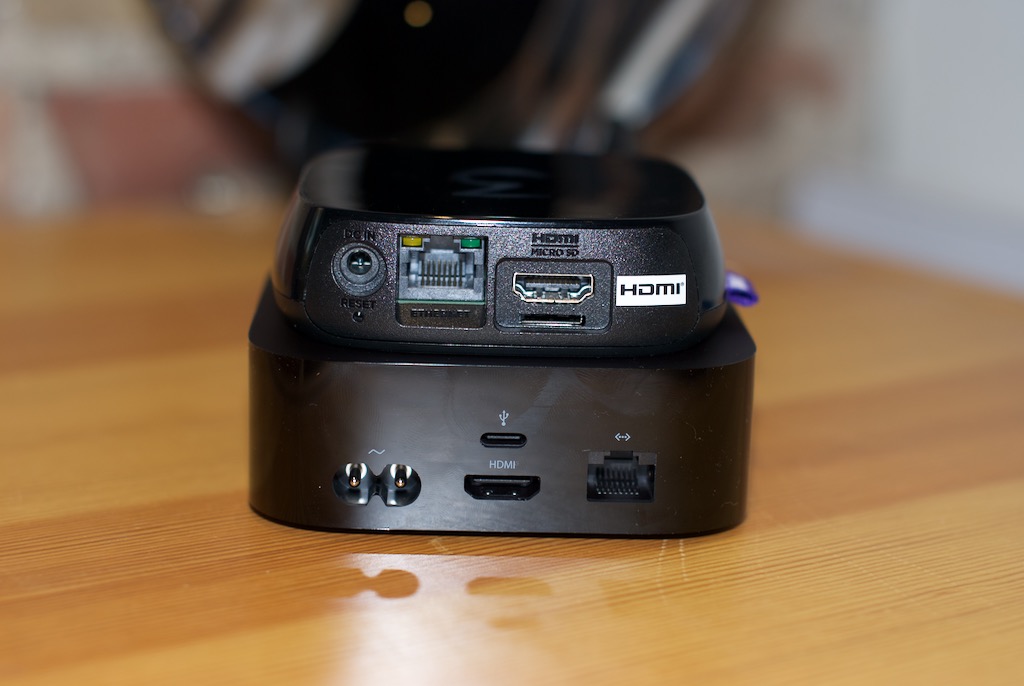“I’d like to create an integrated television set that is completely easy to use. It would be seamlessly synced with all of your devices and with iCloud. It will have the simplest user interface you could imagine. I finally cracked it.” — Steve Jobs, from Walter Isaacson’s biography.
Apple’s latest incarnation of its Apple TV set-top box doesn’t quite deliver on the bombastic promises of Apple’s late, great founder, but it definitely proves that what was once merely “a hobby” for the company is now a very serious part of its strategy to control every aspect of our digital lives.
And while few were surprised to learn that the new motto for finding something to watch is “There’s an app for that,” what is surprising is just how closely the new Apple TV mirrors the approach taken by Roku, specifically its Roku 3 set-top box. But how do the two really compare, and is the Apple TV worth the extra cash? Let’s take a look…
Home screen: You control the vertical
The first thing you notice after firing up the new Apple TV is the emptiness. After entering your Wi-Fi info (or using an iOS device to automatically beam that setting over Bluetooth) and punching in your iCloud/iTunes credentials, you are greeted with a familiar, but sparsely populated, home screen. Current Apple TV users will immediately recognize the content carousel, which Apple calls the “top shelf,” and the default Movies, TV Shows, Photos, and Music choices immediately below. But with the exception of the new App Store, Computers, and Settings buttons, that’s all you get. Gone are the many and varied choices that litter the default home screen of previous versions of Apple TV. No NBA. No Trailers. No (gasp!) Netflix.
That’s because there’s an entirely new paradigm for the fourth-gen Apple TV — one that follows Roku’s approach — in which the App Store is king. Now, instead of watching what Apple thinks you should watch (it was always a little disconcerting the way options would magically appear and disappear from previous versions), you get to choose your content in the form of TV apps from the App Store. Roku calls them channels, Apple calls them apps. It doesn’t matter what you call them — having a choice about the content on your TV is the biggest reason to buy any set-top box. It just makes sense. Adding content to both the Apple TV and the Roku is super simple.
Content
OK, so both Roku and Apple TV let you choose and download content for your TV. But who has the better selection? Despite being brand-new to the market, the hands-down winner is Apple. You’ll find all of the usual streaming suspects like Netflix, Hulu, YouTube, HBO Now, and tons of sports options, but also a variety of games like Crossy Road and JetPack Joyride, and non-streaming apps such as Houzz and Tastemade. This is probably the most exciting part of the new Apple TV — being able to download iOS apps that have been customized for a 16:9 10-foot experience is a game-changer. The apps look and sound great, even on my rapidly aging 720p plasma TV.
Access to this kind of content already makes the Roku offering pale by comparison, but when you consider that the app store can show you TV versions of apps you’ve already downloaded to your iOS devices — well, it takes the app experience to a whole new level.
It’s not all rainbows and unicorns, however. App discovery on the Apple TV app store is pretty bad right now. You’d never know it from the homepage of the app store, but there are hundreds of apps lurking beneath the few dozen that Apple has chosen to highlight. Worse still, getting to them is downright painful. If you don’t know the name of the app you’re looking for, you’re faced with browsing the alphabet one letter at a time (if you do, though, a quick search by name will reveal it). It took me 10 minutes just to browse all apps from A-E. One can only hope Apple will fix this soon — otherwise I predict an angry mob of developers will soon beat down the doors of 1 Infinite Loop.
Roku’s channel offering may not be as diverse as Apple’s apps, but at least you can find them all, whether by search or by browsing the categories.
Siri remote
If being able to customize the Apple TV experience with apps is the biggest change to what you can watch, then the new Siri remote is certainly the biggest difference to how you watch it. The design is pure Apple — thin, light, and comfortable in the hand. You have to give Apple credit for a layout that puts its signature touch surface area and its physical buttons both within easy reach of your thumb without your needing to modify your grasp. The touchpad is very responsive, with gestures that happen onscreen in perfect sync. Some of my upward swipes weren’t recognized, but that proved to be less annoying once I realized that swipes aren’t always required. You can simply tap lightly on the corresponding edge of the touchpad to achieve four-way movement, something which I found myself doing a lot — constant thumb swiping is tiring. When you press the touch area to click (that’s how you select), it reacts with the same satisfying movement that you find on Apple’s magic mouse. Yes, it’s a great click.
Despite the touchpad’s responsiveness, I find that I miss the simple four-way button from both Apple’s previous remote design and all of the current Roku devices. Not only is swiping more tiring than tapping, tapping is more tiring than clicking. The extra effort involved in making sure your thumb contacts the touch area without accidentally pressing it (and thus clicking instead of tapping) might seem like a nitpick, but over time, it starts to feel like an unnecessarily difficult UI.
Nowhere is this more apparent than when trying to enter text using the Apple TV’s new (and, I’d argue, not improved) on-screen keyboard. Because of its wide, A-to-Z layout, there’s a lot of navigation required to enter anything but the shortest of email addresses or passwords. And if your password uses mixed cases (as it should), heaven help you. The touch area does help you speed up the process by letting you fast-swipe from side to side, but because this can’t be done with any real precision, overshooting the mark is all too easy. After a few moments of this, I reached for my iPhone in hopes of using Apple’s Remote app — a fix that has saved me on more than one occasion from tearing my hair out. No such luck. The Remote app is not yet compatible with the fourth-gen Apple TV. Bald is beautiful, right?
Speak and be heard
I suppose Apple would argue that all that tapping and clicking is actually outdated now that Siri is at your beck and call via the remote’s dual microphones and dedicated Siri button. Ideally, that’s exactly what I would do: ask Siri for everything. She can answer questions like “Who directed The Usual Suspects?” quickly and accurately, using iTunes as her main database. Want a weather forecast, stock quote, or sports score? Just ask. Her ability to respond to multistage enquiries is also pretty cool; for instance, when you say “Show me James Bond movies,” and then “Just the ones with Roger Moore,” Siri dutifully presents all of the Bond movies from iTunes and then narrows the list to those that star Moore. It’s very satisfying, and it makes Roku’s voice search feature seem simplistic by comparison. In both Roku and Apple, a search for a movie or TV show reveals all of your viewing options — not just what you can see via your installed apps, but also choices that exist on all apps from the App store.
Sadly, Siri’s ability to do our bidding is limited. For the moment at least, Siri can’t help you find apps that you have not already downloaded (but she will open any apps that are installed). She can’t search your music library. And she won’t take dictation, which would be a welcome way to deal with that nasty on-screen text input. I fully expect Siri’s Apple TV abilities to grow over time, just as they have on iOS, but the waiting (to quote Tom Petty) is the hardest part.
For its part, Roku has chosen to limit voice recognition to search functionality. It can’t tell you the weather forecast, and it won’t open a channel for you if you speak the channel’s name, but given how easy Roku’s interface is to navigate with its old-fashioned button-based remote, I’m OK with this limitation … for now. Still, Apple’s track record at imbuing Siri with greater intelligence over time should definitely keep Roku on its toes.
Let the games begin
Games on the new Apple TV are dazzling — at least, when compared to anything other than a PS3/4 or an Xbox. Hardcore gamers will not be impressed, but Roku users will be blown away. So far as I can tell, based on downloading titles such as Crossy Road, Asphalt 8: Airborne, and Jetpack Joyride, the graphics, sound, and gameplay are just as good as they would be on an iPhone or iPad. If you enjoy casual gaming on these devices, you’ll get a kick out of seeing and playing them on the big screen — especially if you have a decent sound system. That is, if you can handle playing them with the Siri Remote.
Apple built its Siri remote with a full suite of motion sensors, which give it the ability to control games just like Nintendo’s Wiimote and the Roku 3’s remote do (there’s an optional loop accessory that fits into the Lightning connector, making it even more Wii-like). The Siri remote’s accuracy is similar to these controllers, too. However, in making its remote the gorgeous, svelte object that it is, Apple has greatly diminished its comfort as a gaming tool. Because you can’t grip it from the sides without risking inadvertent clicks on the touch area, you need to cradle it gingerly using three fingers per hand. This isn’t an issue with a game like Crossy Road, whose control scheme consists of nothing more than clicks and swipes, but with racing games like Asphalt 8: Airborne and Breakneck, it feels really awkward. Points go to Roku’s remote, which looks like an SUV when sitting next to the Ferrari that is the Siri remote, but feels more substantial and far more comfortable when being used as a game controller.
The lack of gaming cred is partially compensated for by the new Apple TV’s ability to pair with third-party remotes. Wait, don’t get too excited. It will only pair with iOS-compatible controllers — not those made for Sony’s PlayStation or Microsoft’s Xbox, regardless of their underlying Bluetooth technology. Maybe Apple reckons that’s no biggie, given that Apple TV games won’t generally appeal to console users, but given the brains inside that little black box, I anticipate more involved titles soon, and it would be great to play them with the two best controllers on the planet.
Extras
The new Apple TV has some thoughtful extras that are pure Apple in their “I don’t need it, but it’s so cool” nature. Things like the new Aerial screensaver, which offers mesmerizing slow-moving aerial shots of San Francisco that update to reflect your current time of day. It’s just the first of many such screensavers that can be automatically downloaded every month. There’s also the new “idle focus” feature, which subtly dims out the home screen, leaving just the currently selected button fully bright for a while after you’ve set the remote down. It’s a very convenient way to figure out where you left off.
The Apple TV can also now control your home theater’s volume over HDMI — a handy feature that means there’s no need to grab for a second remote. Well, almost no reason — a mute button would be a welcome addition.
The Roku 3 remote features an included headphone jack, which I’ve always thought was a brilliant idea, especially for couples who have different TV viewing habits in the bedroom. You can use the earbuds that Roku includes, or any others you have lying around. But Apple, not to be outdone, will let you pair a set of Bluetooth headphones to the Apple TV. It’s a great alternative to the Roku scheme, but I’m not sure if it’s actually better. You’d have to weigh the cost of Bluetooth headphones and the need to recharge them against the hassle of using buds with wires.
What the Apple TV still lacks — and I suspect will continue to lack forever — is the ability to view or listen to content from an external storage device like a USB stick. That one little USB port on the side of the Roku 3 makes all the difference when you can’t find what you want though your existing subscriptions. Torrent files may not always be ethical, but there’s no denying that a big chunk of users out there take advantage of them and want a way to play them without the tedious process of converting them to an iTunes-friendly format. On the other hand, the need for a USB port might soon be a thing of the past as well. With an App store, Apple is effectively opening up its TV platform to all kinds of uses — including support for non-iTunes media playback. In fact, as of just a few hours ago, Plex now has an Apple TV app, which means the doors to unfettered media consumption are now open.
Conclusion
In the contest between the Roku 3 and the new Apple TV, it comes down to content. Both devices offer superb streaming entertainment options with search features and navigation that make it very easy to quickly get what you want. If what you need is Netflix/Amazon/Hulu and a device that will help you cut the cord, the Roku 3 at $99 is still very hard to beat.
But if you’re looking for something more — something between a Roku and a PS3/4 — but with all of the hallmarks of the Apple ecosystem, the new Apple TV represents a tremendous value, starting at $150 for the 32GB model (the 64GB model costs $199). With its dedicated App store featuring a variety of free and paid apps, including iOS favorites, and elegant and powerful voice recognition thanks to Siri, it offers much more bang for your buck than any other device at these price points.
Though the Siri remote doesn’t feel as substantial or as comfortable when playing games, this is a bit of a moot point given that Roku’s games don’t hold a candle to Apple’s app store offerings. Besides, the ability to buy third-party devices should give gaming enthusiasts a decent alternative.
Consumers looking for a way to upgrade their living room experience will find the new Apple TV a worthy addition to their current home theater setup.
Update: A few of the commenters below have pointed out that this review doesn’t compare (ahem) apples to apples given the Roku 4 ($129) is now available. While this is correct, a Roku 4 was not available for direct comparison and we didn’t think that should be a show-stopper. The Roku 4’s major new feature is 4K support — certainly a nice-to-have feature in terms of future-proofing, but hardly a must-have. All 4K TVs can upscale non-4K content without the need of a dedicated device, not to mention the bandwidth requirements for 4K streams. The only other feature the Roku 4 offers over the 3 is a remote control locator. Handy, for sure, but also not something that distinguishes the Roku 4 experience significantly.
VentureBeat's mission is to be a digital town square for technical decision-makers to gain knowledge about transformative enterprise technology and transact. Learn More







